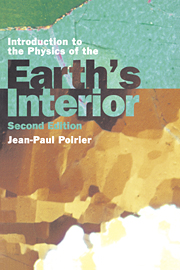Book contents
- Frontmatter
- Contents
- Preface to the first edition
- Preface to the second edition
- Introduction to the first edition
- 1 Background of thermodynamics of solids
- 2 Elastic moduli
- 3 Lattice vibrations
- 4 Equations of state
- 5 Melting
- 6 Transport properties
- 7 Earth models
- Appendix PREM model (1s) for the mantle and core
- Bibliography
- Index
Preface to the second edition
Published online by Cambridge University Press: 05 June 2012
- Frontmatter
- Contents
- Preface to the first edition
- Preface to the second edition
- Introduction to the first edition
- 1 Background of thermodynamics of solids
- 2 Elastic moduli
- 3 Lattice vibrations
- 4 Equations of state
- 5 Melting
- 6 Transport properties
- 7 Earth models
- Appendix PREM model (1s) for the mantle and core
- Bibliography
- Index
Summary
Almost ten years ago, I wrote in the introduction to the first edition of this book: ‘It will also probably become clear that the simplicity of the inner Earth is only apparent; with the progress of laboratory experimental techniques as well as observational seismology, geochemistry and geomagnetism, we may perhaps expect that someday “Physics of the Inner Earth” will make as little sense as “Physics of the Crust”’. We are not there yet, but we have made significant steps in this direction in the last ten years. No geophysicist now would entertain the idea that the Earth is composed of homogeneous onion shells. The analysis of data provided by more and better seismographic nets has, not surprisingly, revealed the heterogeneous structure of the depths of the Earth and made clear that the apparent simplicity of the lower mantle was essentially due to its remoteness. We also know more about the core.
Mineral physics has become an essential part of geophysics and the progress of experimental high-pressure and high-temperature techniques has provided new results, solved old problems and created new ones. Samples of high-pressure phases prepared in laser-heated diamond-anvil cells or large-volume presses are now currently studied by X-ray diffraction, using synchrotron beams, and by transmission electron microscopy. In ten years, we have thus considerably increased our knowledge of the deep minerals, including iron at core pressures. We know more about their thermoelastic properties, their phase transitions and their melting curves.
- Type
- Chapter
- Information
- Introduction to the Physics of the Earth's Interior , pp. xii - xivPublisher: Cambridge University PressPrint publication year: 2000



